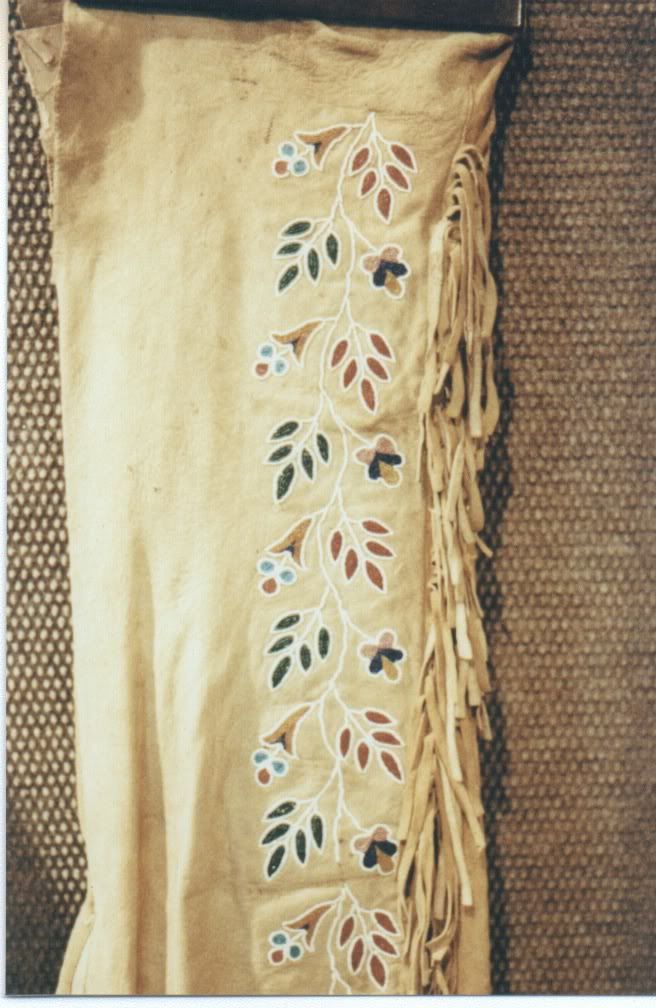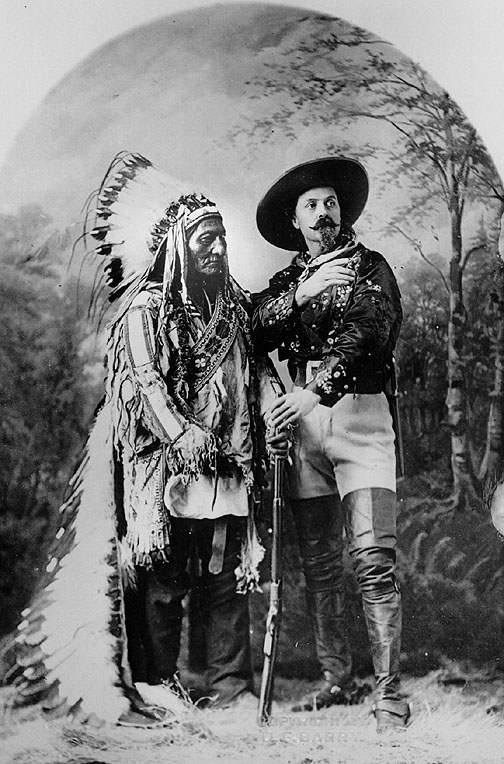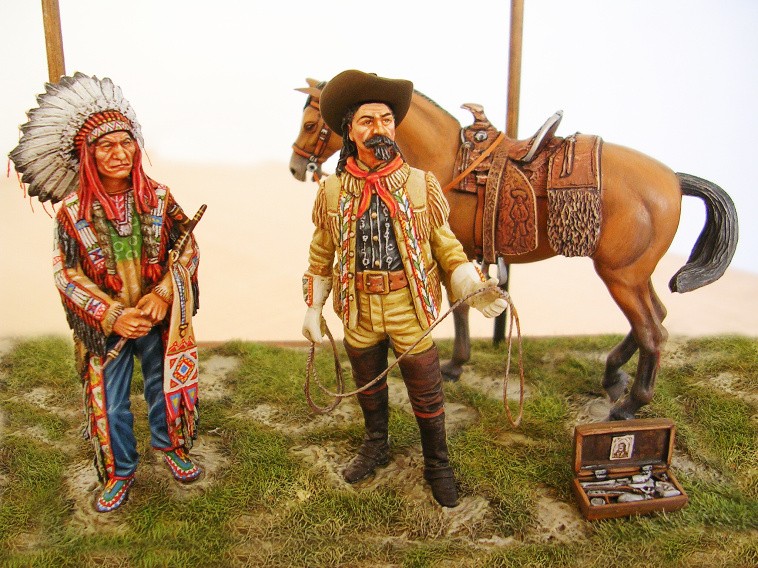Cody's life itself seemed to embody and symbolize the history of the west. Born in 1846 in a log cabin in Iowa, he grew up on the cutting edge of Turner's notorious "meeting point of savagery and civilization." He was present for every key moment in westward expansion, including the gold rush, the Pony Express, the building of the railroads, and cattle herding on the Great Plains--and found himself playing a part in nearly every one of these crucial stages of development. Cody's father believed that Kansas should be a free state, but many of the other settlers in the area were pro-slavery .sQBN5mFP(0fg~~_35.JPG)
Bleeding Kansas, Bloody Kansas or the Border War, was a series of violent events, involving anti-slavery Free-Staters and pro-slavery "Border Ruffian" elements, that took place in the Kansas Territory and the western frontier towns of the U.S. state of Missouri roughly between 1854 and 1858. At the heart of the conflict was the question of whether Kansas would enter the Union as a free state or slave state. As such, Bleeding Kansas was a proxy war between Northerners and Southerners over the issue of slavery in the United States. The term "Bleeding Kansas" was coined by Horace Greeley of the New York Tribune; the events it encompasses directly presaged the American Civil War.
Bleeding Kansas, Bloody Kansas or the Border War, was a series of violent events, involving anti-slavery Free-Staters and pro-slavery "Border Ruffian" elements, that took place in the Kansas Territory and the western frontier towns of the U.S. state of Missouri roughly between 1854 and 1858. At the heart of the conflict was the question of whether Kansas would enter the Union as a free state or slave state. As such, Bleeding Kansas was a proxy war between Northerners and Southerners over the issue of slavery in the United States. The term "Bleeding Kansas" was coined by Horace Greeley of the New York Tribune; the events it encompasses directly presaged the American Civil War.
The United States had long struggled to balance the interests of slaveholders and abolitionists. The events later known as Bleeding Kansas were set into motion by the Kansas–Nebraska Act of 1854, which nullified the Missouri Compromise and instead implemented the concept of popular sovereignty. An ostensibly democratic idea, popular sovereignty stated that the inhabitants of each territory or state should decide whether it would be a free or slave state; however, this resulted in immigration en masse to Kansas by activists from both sides. At one point, Kansas had two separate governments, each with its own constitution, although only one was federally recognized. On January 29, 1861, Kansas was admitted to the Union as a free state, less than three months before the Battle of Fort Sumter which began the Civil War. Here and below are some typical examples of commercial Buckskin clothing appropriate for a contract scout ca 1870
Here and below are some typical examples of commercial Buckskin clothing appropriate for a contract scout ca 1870
/ commandant miniatures
commandant miniatures
0
 Here and below are some typical examples of commercial Buckskin clothing appropriate for a contract scout ca 1870
Here and below are some typical examples of commercial Buckskin clothing appropriate for a contract scout ca 1870/
 commandant miniatures
commandant miniatures0

While giving an anti-slavery speech at the local trading post, he so inflamed the supporters of slavery in the audience that they formed a mob and one of them stabbed him. Cody helped to drag his father to safety, although he never fully recovered from his injuries. The family was constantly persecuted by the supporters of slavery, forcing Isaac Cody to spend much of his time away from home. His enemies learned of a planned visit to his family and plotted to kill him on the way. Cody, despite his youth and the fact that he was ill, rode 30 mi.jpg) to warn his father. Cody's father died in 1857 from complications from his stabbing.
to warn his father. Cody's father died in 1857 from complications from his stabbing.
After his father's death, the Cody family suffered financial difficulties, and Cody, aged only 11, took a job with freight carrier as a "boy extra," riding up and down the length of a wagon train, delivering messages. From here, he joined Johnston's Army as an unofficial member of the scouts assigned to guide the Army to Utah to put down a falsely-reported rebellion by the Mormon population of Salt Lake City. According to Cody's account in Buffalo Bill's Own Story, this was where he first began his career as an "Indian fighter".
From here, he joined Johnston's Army as an unofficial member of the scouts assigned to guide the Army to Utah to put down a falsely-reported rebellion by the Mormon population of Salt Lake City. According to Cody's account in Buffalo Bill's Own Story, this was where he first began his career as an "Indian fighter".
A career as a scout during the Civil War earned him his nickname and established his notoriety as a model frontiersman. During his scouting days, Cody also added Indian warfare to his already impressive resumé of mythical western experiences. In confrontations over land ownership in the 1860's
During his scouting days, Cody also added Indian warfare to his already impressive resumé of mythical western experiences. In confrontations over land ownership in the 1860's and 1870's, Cody distinguished himself as a superior scout and expedition leader, but in late summer of 1876, he moved from national hero to mythic legend.
and 1870's, Cody distinguished himself as a superior scout and expedition leader, but in late summer of 1876, he moved from national hero to mythic legend. The defeat of Custer and his Cavalry at Little Big Horn on June 25 retrieved the Indian Wars from back-page news and brought them to the headlines. In the wake of public shock and outrage over this defeat, Cody made real the images enacted in his Wild West Show when the Fifth Cavalry avenged Custer's defeat in a Cheyenne skirmish at Warbonnet Creek, Nebraska on July 17.
The defeat of Custer and his Cavalry at Little Big Horn on June 25 retrieved the Indian Wars from back-page news and brought them to the headlines. In the wake of public shock and outrage over this defeat, Cody made real the images enacted in his Wild West Show when the Fifth Cavalry avenged Custer's defeat in a Cheyenne skirmish at Warbonnet Creek, Nebraska on July 17.  Cody confronted Cheyenne leader Yellow Hand, shot and scalped him, and as the story goes, raised the scalp of the dead warrior to the charging Fifth Cavalry while delcaring "First scalp for Custer!" Whether any gesture of victory and revenge occurred is uncertain, but the killing of Yellow Hand was genuine. No matter what may have transpired after he claimed that scalp, Cody the man met Cody the legend on the bluffs of the Warbonnet Creek, and history and myth commingled to validate the authority of the Wild West Show.
Cody confronted Cheyenne leader Yellow Hand, shot and scalped him, and as the story goes, raised the scalp of the dead warrior to the charging Fifth Cavalry while delcaring "First scalp for Custer!" Whether any gesture of victory and revenge occurred is uncertain, but the killing of Yellow Hand was genuine. No matter what may have transpired after he claimed that scalp, Cody the man met Cody the legend on the bluffs of the Warbonnet Creek, and history and myth commingled to validate the authority of the Wild West Show.  Paul Fees, curator at the Buffalo Bill Historical Society in Cody, Wyoming, has commented that "the myth of the West was first of all a myth of accomplishment shared by all Americans, hence a myth of unity." Buffalo Bill's show enacted this myth in its simplest terms in performances from California to New York, and from London to Rome. Many historians and Buffalo Bill afficionados would agree that Cody did not merely represent the west, but he became the west, in his own mind and in the minds of others.
Paul Fees, curator at the Buffalo Bill Historical Society in Cody, Wyoming, has commented that "the myth of the West was first of all a myth of accomplishment shared by all Americans, hence a myth of unity." Buffalo Bill's show enacted this myth in its simplest terms in performances from California to New York, and from London to Rome. Many historians and Buffalo Bill afficionados would agree that Cody did not merely represent the west, but he became the west, in his own mind and in the minds of others.  Cody's portrayal of his beloved region is nonetheless a troubling one. The presentation of the west in the features of the show and in the proliferation of marketing and advertising surrounding it demonstrate difficulties in accurately rendering the history and culture of the west, sorting out the complicated relationship between the settlers and the Native Americans, and making distinctions between the fact and fiction of Buffalo Bill himself. Cody might never have imagined the lasting power his myths had on the American imagination, but the images and legends born in his show penetrate popular culture even in the late Twentieth Century. Modern western entertainment, such as rodeos and cattle drives, tourism and chamber-of-commerce literature, and cinematic portrayals too numerous too count exhibit the influences of the Wild West Show.
Cody's portrayal of his beloved region is nonetheless a troubling one. The presentation of the west in the features of the show and in the proliferation of marketing and advertising surrounding it demonstrate difficulties in accurately rendering the history and culture of the west, sorting out the complicated relationship between the settlers and the Native Americans, and making distinctions between the fact and fiction of Buffalo Bill himself. Cody might never have imagined the lasting power his myths had on the American imagination, but the images and legends born in his show penetrate popular culture even in the late Twentieth Century. Modern western entertainment, such as rodeos and cattle drives, tourism and chamber-of-commerce literature, and cinematic portrayals too numerous too count exhibit the influences of the Wild West Show. 
.jpg) to warn his father. Cody's father died in 1857 from complications from his stabbing.
to warn his father. Cody's father died in 1857 from complications from his stabbing. After his father's death, the Cody family suffered financial difficulties, and Cody, aged only 11, took a job with freight carrier as a "boy extra," riding up and down the length of a wagon train, delivering messages.
 From here, he joined Johnston's Army as an unofficial member of the scouts assigned to guide the Army to Utah to put down a falsely-reported rebellion by the Mormon population of Salt Lake City. According to Cody's account in Buffalo Bill's Own Story, this was where he first began his career as an "Indian fighter".
From here, he joined Johnston's Army as an unofficial member of the scouts assigned to guide the Army to Utah to put down a falsely-reported rebellion by the Mormon population of Salt Lake City. According to Cody's account in Buffalo Bill's Own Story, this was where he first began his career as an "Indian fighter". A career as a scout during the Civil War earned him his nickname and established his notoriety as a model frontiersman.
 During his scouting days, Cody also added Indian warfare to his already impressive resumé of mythical western experiences. In confrontations over land ownership in the 1860's
During his scouting days, Cody also added Indian warfare to his already impressive resumé of mythical western experiences. In confrontations over land ownership in the 1860's The defeat of Custer and his Cavalry at Little Big Horn on June 25 retrieved the Indian Wars from back-page news and brought them to the headlines. In the wake of public shock and outrage over this defeat, Cody made real the images enacted in his Wild West Show when the Fifth Cavalry avenged Custer's defeat in a Cheyenne skirmish at Warbonnet Creek, Nebraska on July 17.
The defeat of Custer and his Cavalry at Little Big Horn on June 25 retrieved the Indian Wars from back-page news and brought them to the headlines. In the wake of public shock and outrage over this defeat, Cody made real the images enacted in his Wild West Show when the Fifth Cavalry avenged Custer's defeat in a Cheyenne skirmish at Warbonnet Creek, Nebraska on July 17.  Cody confronted Cheyenne leader Yellow Hand, shot and scalped him, and as the story goes, raised the scalp of the dead warrior to the charging Fifth Cavalry while delcaring "First scalp for Custer!" Whether any gesture of victory and revenge occurred is uncertain, but the killing of Yellow Hand was genuine. No matter what may have transpired after he claimed that scalp, Cody the man met Cody the legend on the bluffs of the Warbonnet Creek, and history and myth commingled to validate the authority of the Wild West Show.
Cody confronted Cheyenne leader Yellow Hand, shot and scalped him, and as the story goes, raised the scalp of the dead warrior to the charging Fifth Cavalry while delcaring "First scalp for Custer!" Whether any gesture of victory and revenge occurred is uncertain, but the killing of Yellow Hand was genuine. No matter what may have transpired after he claimed that scalp, Cody the man met Cody the legend on the bluffs of the Warbonnet Creek, and history and myth commingled to validate the authority of the Wild West Show.  Cody's portrayal of his beloved region is nonetheless a troubling one. The presentation of the west in the features of the show and in the proliferation of marketing and advertising surrounding it demonstrate difficulties in accurately rendering the history and culture of the west, sorting out the complicated relationship between the settlers and the Native Americans, and making distinctions between the fact and fiction of Buffalo Bill himself. Cody might never have imagined the lasting power his myths had on the American imagination, but the images and legends born in his show penetrate popular culture even in the late Twentieth Century. Modern western entertainment, such as rodeos and cattle drives, tourism and chamber-of-commerce literature, and cinematic portrayals too numerous too count exhibit the influences of the Wild West Show.
Cody's portrayal of his beloved region is nonetheless a troubling one. The presentation of the west in the features of the show and in the proliferation of marketing and advertising surrounding it demonstrate difficulties in accurately rendering the history and culture of the west, sorting out the complicated relationship between the settlers and the Native Americans, and making distinctions between the fact and fiction of Buffalo Bill himself. Cody might never have imagined the lasting power his myths had on the American imagination, but the images and legends born in his show penetrate popular culture even in the late Twentieth Century. Modern western entertainment, such as rodeos and cattle drives, tourism and chamber-of-commerce literature, and cinematic portrayals too numerous too count exhibit the influences of the Wild West Show. 
As a culture, we now attempt to deconstruct the Buffalo Bill myths Cody embodied in his life and in his work, we strive for accuracy and fairness in order to right the wrongs wrought by history and myth, and we work to reverse the sociocultural effects produced and perpetuated by these myths, but to discount the power of these images and relegate them to collective error, regret, or embarrassment would be to ignore the ideas which shaped and reflect our history. From our current perspective, we can recognize the racial, cultural, and ecological problems which describe the myths of western settlement. But these myths are woven into our national history, and however uneasy we have become with them, the emotions they evoke in all of us represent a curcial piece of our national heritage. The story of Buffalo Bill is a factual tale of our cultural history and a fictional story of the west which continues to color our perceptions of the west and the people who inhabit it. The myth of the Wild West is not sufficient to guide policy or government in the modern West, but it has certainly earned its place in our national folklore.  pietro ballarini
pietro ballarini
 pietro ballarini
pietro ballarini
No comments:
Post a Comment